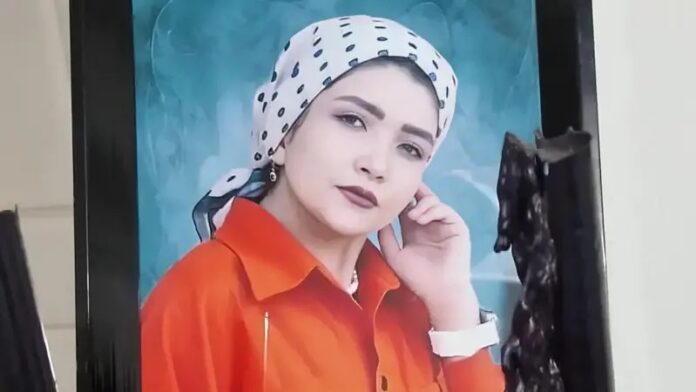In recent days, the tragic discovery of the dismembered remains of Kobra Rezaei, a young Afghan migrant woman, has drawn significant attention from both the public and the media. After being missing for nearly 50 days, her partial remains were initially found in a garbage dump in the city of Pishva, near Tehran. Subsequently, the rest of her body was recovered from the home of a 32-year-old Iranian man. This individual—one of her colleagues—confessed to premeditated murder and the mutilation of her body after the police presented forensic evidence.
The Incident
Kobra Rezaei, known by some as “Shaghayegh Rezaei,” was a 26-year-old woman who went missing approximately 52 days ago, on the 20th of Hamal (April 8), after leaving her workplace at a vacuum cleaner factory in the industrial zone of Pakdasht. She never returned home. After two days of unanswered calls and growing concern, her family reported her disappearance to the police.
Weeks later, in early Saur (late April), portions of a dismembered body were found in a trash container near Pakdasht. The remains—specifically a hand and a foot—had been partially destroyed using acid and could not be immediately identified. Police requested the family’s cooperation for potential identification. Although the family initially did not believe the remains belonged to their daughter, DNA testing conducted by the forensic office confirmed that the remains were indeed those of Kobra Rezaei.
While the motive for the murder remains officially unclear, some accounts circulating on social media provide a clearer picture. Batool Haidari, a former university professor with experience living in Iran, wrote:
“According to police investigations and the victim’s family, a suspect was identified: Ali Khaleqi, a 32-year-old married security guard at the factory, known to be suspicious and problematic. Reportedly, Kobra, who worked in the accounting department, had discovered evidence of theft involving equipment and supplies, allegedly committed by Khaleqi. In an effort to silence her, he initially threatened her and later tried to express romantic interest. On the day of the incident—likely April 8—Kobra stayed late at work for accounting tasks. As she left, she encountered Khaleqi once again. When he repeated his advances, she firmly rejected him, saying she was engaged and working to earn money for her dowry. She reportedly warned him that if the harassment continued, she would speak to his wife.”
Khaleqi, distrusting her and fearing exposure, is believed to have killed Kobra during a sudden confrontation. He then attempted to destroy her body using acid. Unable to fully eliminate the remains, he placed part of the body in a plastic bag and disposed of it in a public bin.
Following the discovery and DNA identification, police cross-referenced the case with missing persons reports. Mobile phone tracking confirmed that the last recorded location of Kobra’s device was Khaleqi’s home. Further investigation revealed that he had hidden her belongings in his residence. Text messages between the two were also reviewed, highlighting threats and Khaleqi’s fear of being exposed.
He was arrested shortly thereafter. After initially denying the charges, he ultimately confessed. Another individual who had been detained in connection to the case was later released. The case has since been referred to the judiciary, and Khaleqi has been transferred to prison. Legal proceedings are ongoing under the supervision of Pishva’s law enforcement and judicial authorities.
Legal Perspective
From a legal standpoint, Kobra Rezaei’s case encompasses several serious criminal charges under Iranian law: premeditated murder, mutilation of a corpse, and the attempted destruction of evidence using acid. These are offenses that carry heavy penalties under the Iranian Penal Code, including capital punishment (qisas).
Given that the victim and her family were Afghan migrants—and possibly lacked formal legal residency—the legal handling of the case may face additional challenges. These could include limited access to legal representation, social support, or public advocacy due to political, security, or systemic barriers.
Media Perspective
An analysis of Iranian media coverage indicates that the story has been largely confined to local reporting, with key aspects such as the victim’s migrant status being omitted. In contrast, cases involving Afghan suspects often receive wider coverage in Iranian media.
Some English-language migrant rights platforms have pointed to a broader pattern: violence against Afghan migrants is often censored or significantly underreported. Meanwhile, Afghan social media users and activists have rallied around hashtags like #KobraRezaei and #JusticeForKobraRezaei, calling for justice and support for her family. Several Afghan human rights activists have issued formal statements demanding accountability.
At the same time, some Afghan civil society groups have criticized the silence of Iranian human rights advocates, noting:
“Iranian activists were vocal in the case of Elahe Hosseinnejad, but they have remained silent regarding Kobra Rezaei.”
Social Perspective
Kobra’s circumstances reflect the broader experiences of millions of Afghan migrants in Iran. These individuals often face systemic exclusion from health care, formal education, insurance, and legal protections. According to a recent Human Rights Watch report, Afghan migrants in Iran are increasingly subjected to forced deportation, arbitrary detention, and legal discrimination.
Social marginalization and residential segregation are major factors that increase the vulnerability of migrant communities. In such settings, gender-based violence, individual crimes, and the lack of effective legal remedies are more likely to occur—and more likely to go unaddressed.
Conclusion
The case of Kobra Rezaei is not merely a murder investigation—it is a tragedy unfolding at the intersection of migration, gender, systemic vulnerability, and institutional neglect. The response of Iran’s judiciary and media will be pivotal in shaping public trust and accountability.
Ultimately, this case raises fundamental questions about the protection of migrants, the transparency of justice systems, and the responsibility of media and civil society to speak out—regardless of a victim’s legal status or nationality.



